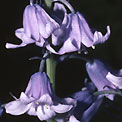Hybrid bluebell, Hyacinthoides x massartiana

Other common names: none known
Other scientific names: Hyacinthoides x variabilis.
Description

The hybrid bluebell shares characteristics with both the Spanish and native bluebell, which can make it difficult to identify.
Hybrid bluebells are perennial herbs growing from a bulb.
The basal leaves are few in number (3-8) per bulb. Leaves may be between 20-50cm long and 10-30mm wide and are erect at first but become floppy and spread across the ground later in the season. The leaf shape is usually linear-lanceolate in outline with an acute tip. The leaves are smooth, shiny and slightly succulent.
The flower spike is usually 20-50cm high, with the flowers arranged in a raceme that droops or nods slightly to one side. Each raceme normally has between 4 and 15 flowers that are attached to the main stem on all sides.
The flowers hang down or point outwards, sometimes towards one side of the main stem. Each flower has two linear-lanceolate bracts, one usually longer than the other, at the base of the flower stalk. The flower stalk is normally 8-20mm long. The flowers are usually dark to pale blue (sometimes white or pink). Each flower is made up of six petals that are fused together at the base to form an open bell. Flowers are normally 10-20mm in diameter and each petal is usually 12-17mm long. The petals are spreading (erecto-patent) and are usually slightly rolled back.
The three inner stamens are about three quarters of the length of the three outer stamens. The filaments of the outer stamens are attached to the petal for out three quarters of their length. The anthers are usually pale greeny-blue. Flowers are usually weakly scented, particularly on warm days. The hybrid is apparently fully fertile and produces abundant seed.

Origin and Distribution
The Hybrid bluebell appears to have formed frequently within the British Isles. Hybrid bluebells are mainly found in the vicinity of villages, towns and cities. They are frequent in churchyards, cemeteries, parks and gardens, they also occur as either escapes or 'throw-outs' alongside road-verges, wastelands, hedgerows and woodland borders. In some urban woodlands they are apparently the most abundant Bluebell. The distribution of this Bluebell is not accurately known but it appears to be infrequent in upland areas, particularly in Scotland.
